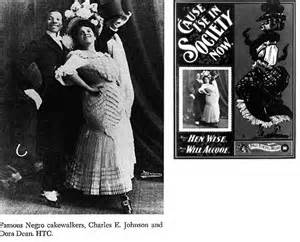
Dora Dean was born in Covington in 1872, and got into show business as the “Black Venus.” She was born as Dora Babbige; Dean was evidently her stage name. Her initial job in show business was as a “statute girl” – essentially striking dramatic poses and looking pretty. She eventually took on a partner, a tap dancer named Charles E. Johnson, and together they became a major act. They took an obscure dance from the south, The Cakewalk, and popularized it in America. They toured an African American Tour circuit with The Creole Show, but eventually joined a White circuit, The Orpheum Circuit, one of the few Black acts to do so.
Johnson and Dean were a song and dance act, but unlike most such Black acts, they avoided self deprecation and ragged clothes in favor of elegance sophistication, and dignity. They appeared in full formal evening wear. They were one of the first acts to make use of a strobe light, and Johnson was one of the very first dancers to put meat taps on his shows. Neither Johnson nor Dean actually sang, but “talked” their songs. Dean was famous not for her singing nor her dancing, but for being able to communicate warmth and personal charm from whatever she did on stage.
Johnson & Dean were the most famous cakewalk artists at the turn of the century. They claimed to have introduced that high kicking dance to Broadway in 1895. Four years earlier, Dora Dean, along with her partner and future husband, Charles E. Johnson, got their start in Sam T Jack’s Creole Company. This was the first African-American show to break from the strict minstrel tradition of all male performers and allow women on stage as performers. Dora Dean’s first job on stage was to pose as a statue. Johnson eventually became the company’s leading man after starting as singer and banjo player. Bob Cole was also a member of this troupe.
In 1893, Johnson and Dean got married and left the Creole Company. Soon after, they put together an act for the Chicago World’s Fair that was described as eccentric dancing. Later, after joining the vaudeville circuit, they became known as the King and Queen of Colored Aristocracy.Twice during these years they played from coast to coast, doing 52 weeks of continuous business. In 1901, they traveled to Berlin, Germany, where Dean was asked to sit for a life-size painting by Ernest Hellman, then one of Germany’s foremost artists. During this tour they also entertained in England and France, bringing the cakewalk and “coon” songs to the Continent.
After returning to the United States they began to bill themsleves as the Colored Fashion Plates. At this time, they were described as “the best entertainers of their race”, giving the Broadway duo of Williams & Walker serious competition. In 1904, Johnson & Dean traveled back to London where they topped the bill at the Palace Theatre. During what eventually became a seven year tour, they performed in Austria and Hungary as well as in Germany, France, and Russia. When they returned to the U.S. in 1909 they incorporated some of their favorite overseas material into their act but were criticized by the press for not being black enough. Dora Dean’s diamonds and elegant clothing as well as Johnson’s pantomimes of “foreign” characters were a shock to American reviewers who expected them to be a typical black act of the period. Johnson and Dean continued to perform across the country entertaining enthusiastic crowds wherever they went.
There was a popular song that amplified their fame, that went:
Say have you ever seen Miss Dora Dean
She is the finest girl you have ever seen.
I’m a-goin’ to try and make this girl my queen
Next Sunday morning I’m goin’ to marry Dora Dean.
From 1901 to 1914 they performed almost exclusively in Europe, where they were an even bigger hit than they were in America. 1914, and the World War ended their European tour, and they split professionally. She went on the act on stage, and did some movies, and in 1930 re-united with Johnson, where he had settled in Hennepin. Minnesota. She died there on December 13, 1949.

